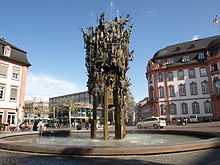Blasius Spreng
Blasius Spreng (born June 25, 1913 in Munich ; † February 10, 1987 there ) was a German painter, sculptor, glass painter and mosaicist .
Life
After an apprenticeship in glass painting at the Mayer'schen Hofkunstanstalt and a goldsmith apprenticeship, Spreng studied at the State School for Applied Arts in Munich in 1931/33 and was a master student of Richard Klein . He then made numerous trips to France, Holland, Italy, the Balkans, Turkey and Egypt. During the Third Reich , Spreng, like numerous artists of his generation, also worked for National Socialist clients and created propaganda work. In 1937 he contributed drawings for the exhibition catalog "Munich - Capital of Movement: Two Thousand Years of German Culture". From 1940/41 he taught free graphics at the Academy of Fine Arts in Nuremberg . In 1941 he designed in völkischem ductus the title box of the exhibition catalog United Germany and the lake (the Deutsches Museum) and in the same way a field post-picture card with the title your for us - We for you for the General Command , Munich.
From the end of 1941 he was drafted into the Todt Organization as a war painter . On the French and Norwegian coasts, he drew, among other things, construction sites for submarine bunkers , which were later to appear as eraser folders . In 1942 three etchings by the artist with architectural motifs were shown at the National Socialist Great Art Exhibition in the Haus der Kunst , Munich.
In the post-war period, Spreng expanded his artistic spectrum. For the rebuilding he created church windows, sculptures and wall designs. Starting out in Munich, where he was quickly considered to be the most important sculptor, he gained a reputation in the art of building sector throughout West Germany. As with the Stuttgart Liederhalle , he took on the overall artistic design, including the design of the floors with mosaics. Lambert Maria Wintersberger was one of his most famous students (from 1959) .
Work by Blasius Spreng
Stained glass
Spreng's glass paintings can be found in the Friedberger Stadtkirche , among other places .
Murals
His wall paintings can be found in the Stuttgart Liederhalle (1956), in the stairwell of the district court building in Coburg (1953), in the government of Lower Franconia , in the Dillingen town hall (1961) and in the Landshut station building .
Mosaic work
His mosaic works are on the facade of the Hoechst administration in Frankfurt a. M., as well as in the interior of the Evangelical Church in Neutraubling, also in the chapel of the Salesianum in Rosental and on the back wall of the choir stalls in the church in the municipal retirement home in Munich-Schwabing and in the Paul-Gerhardt-Church in Mannheim . In 2001 his golden mosaic work was discovered in the Indanthren House, Weinstrasse 3 Munich. In the Worms Theater you can also find mosaic works, the design of which for the stone floor was made by Professor Blasius Spreng, and was executed by Hans Sedlacek, Munich. These are motifs related to theater and music.
Sculpting work
Sculptural works include the Mainz Carnival Fountain (1967) and the Ludwigshafen Palatinate Column . and the granite fountain for the statue of Mary on the market square in Falkenstein .
literature
biography
- Blow up, Blasius . In: Hans Vollmer (Hrsg.): General Lexicon of Fine Artists of the XX. Century. tape 4 : Q-U . EA Seemann, Leipzig 1958, p. 333 .
- Fritz Richard Barran: Art in architecture today: mural, relief and sculpture in contemporary architecture. Art and architecture today. J. Hoffmann Publishing House, 1964
To his work
Primary literature
- Karl Hocheder, Blasius Spreng, Josef Widmann: The reconstruction of the Residenztheater in Munich (ceremony for the opening of the Residenztheater in Munich, brought out by the construction company Josef Widmann. Drawings by Karl Hocheder, original etchings by Blasius Spreng.)
- Blasius Spreng: Secret Carnival Fountain . Ed .: Hans Jörg Jacobi. Erasmus, Mainz 1994 (with an essay by Gottfried Edel and a lecture by Rudi Henkel).
Secondary literature
- The murals by Blasius Spreng in the Domgymnasium and in the Regensburg Building School . In: Baufach-Nachrichten for the East Bavarian area . tape 19/20 , 1953, pp. 17-19 .
- Karl Schramm: The Carnival Fountain in Mainz . Krach, Mainz 1969.
- Guido Harbers: Stuttgart's new song hall . In: Art and the beautiful home . tape 55 (1956/57) . Krach, Mainz, p. 300-305 .
- Eberhard Grunsky: On the monument significance of the Stuttgart Liederhalle . In: Preservation of monuments in Baden-Württemberg . tape 16 . Krach, Mainz 1987, p. 91-112 .
- Klaus Mayer: Fountain of Joy: Meditations on the Mainz Carnival Fountain . Echter-Verlag, Würzburg 1981.
- New teachers at the Academy of Fine Arts: Irma Goecke, Ernst Andreas Rauch, Otto Michael Schmitt, Blasius Spreng; Exhibition; [Städtische Galerie am Königstor, September - December 1941] . Galleries and Art collections, Nuremberg 1941.
- Klaus Benz: Sparkling Mainz joie de vivre: the carnival fountain . Schmidt, Mainz 2011 (Ludwig and Peter Eckes Family Foundations. With photo by Klaus Benz).
- Blow up, Blasius . In: Supreme Building Authority Munich (Hrsg.): Bildwerk Bauwerk Artwork - 30 years of art and state building in Bavaria . Bruckmann, Munich 1990, ISBN 3-7654-2308-4 , p. 280-281 .
Web links
Individual evidence
- ↑ Blasius Spreng: picture card "You for us - We for you" for the General Command, Munich
- ↑ kunstlexikonsaar.de
- ↑ kunstlexikonsaar.de
- ↑ regierung.oberbayern.bayern.de
| personal data | |
|---|---|
| SURNAME | Blow up, Blasius |
| BRIEF DESCRIPTION | German painter, sculptor, glass painter and mosaicist |
| DATE OF BIRTH | June 25, 1913 |
| PLACE OF BIRTH | Munich |
| DATE OF DEATH | February 10, 1987 |
| Place of death | Munich |


